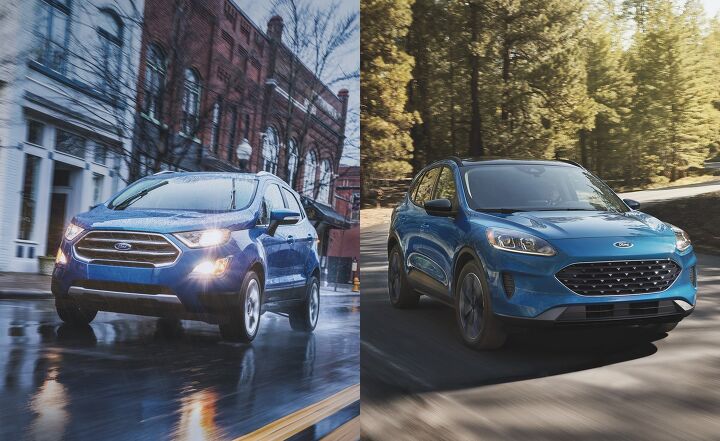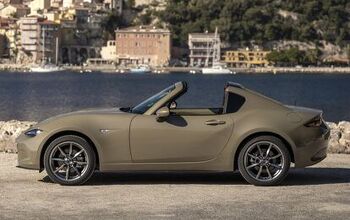Ford EcoSport Vs Ford Escape Comparison: Which Crossover is Right for You?

It should be plain to anyone blessed with the gift of sight that the tastes of most automotive shoppers has permanently shifted to crossovers and SUVs.
Sedans comprise a dwindling proportion of sales and, while some brands continue to shovel investment dollars into four-door cars (thank you, Hyundai and Honda), some have walked away from the segment completely.
Get a Quote on a New Ford EcoSport or EscapeFord is one of those brands, with Jim “Mobility” Hackett presiding over a company that binned all cars save for the venerable Mustang. The wisdom of this decision will surely be debated in marketing classes for years to come.
Two of the brand’s smallest crossover-type vehicles, the EcoSport and Escape, are intended to capture customers who would have otherwise driven home in a Blue Oval sedan or hatchback. Let’s examine how they compare.
Powertrains
EcoSport: Two engines are on offer in the diminutive EcoSport. A 1.0-liter three-cylinder EcoBoost wheezes 123 horsepower and a like amount of torque out of its cast-iron lump. This is a front-wheel drive only affair, so customers who seek the grip of all-wheel drive will have to upgrade to a naturally-aspirated inline-four displacing 2.0-liter and making 166 ponies. Both mills are lashed to a six-speed automatic transmission imbued with start/stop technology.
SEE ALSO: 2020 Ford Escape Hybrid vs 2020 Toyota RAV4 HybridEscape: For the current generation, there are no shortage of powertrain options in the freshly-hewn Escape. The ute makes an opening bid with its 1.5-liter turbocharged three-cylinder making 181 hp and available with front- or all-wheel drive. A boosted 2.0-liter mill makes a healthy 250 ponies and sends power to all four wheels. Hybrid models deploy a 2.5-liter inline-four that, paired with electric propulsion, makes about 200 horsepower. The plug-in hybrid model makes slightly more juice (221 hp) thanks to a more robust pack of electrons.
SEE ALSO: 2019 Hyundai Santa Fe ReviewBottom Line: The new Escape is, without question or shadow of a doubt, the better choice of these two vehicles in terms of powertrain selection. In particular, the 250-horsepower engine—which also makes 275 lb-ft of torque—is a very sprightly option.
Fuel Economy
EcoSport: Despite displacing only 1.0-liter, the smaller of the two EcoSport’s engines fails to crack the 30 mpg mark in any of the EPA estimated ratings. It is allegedly good for 27 mpg in the city and 29 mpg on the highway, making for a combined performance of just 28 mpg. This is without any sort of all-wheel drive system, by the way. Bumping up to the 2.0-liter reduces these numbers to 23, 29, and 25 mpg, respectively. It should be noted that certain versions of the F-150 pickup truck return better mileage than those numbers.
Escape: Owing to its variety of engine and drivetrain combos, the Escape covers a wide spread of fuel economy ratings. A base, front-drive 1.5-liter hits the milestone 30 mpg combined, split between 28 city and 34 mpg highway. Switching to AWD drops those numbers to 28, 26, and 31 mpg, respectively. Opt for the larger EcoBoost motor (available only with AWD), and you’ll trim a further 2 mpg off the combined rating (now 26 mpg) and 3 mpg off the city score (23 mpg).
SEE ALSO: Hyundai Kona vs Hyundai Tucson ComparisonThe hybrid Escape is available with front or all-wheel drive, unlike the RAV4 and CR-V hybrids. Two-wheel drive models post 44 mpg city, 37 mpg highway, for a combined 41 mpg rating. The AWD model barely sees a penalty, with 43, 37, and 40 mpg ratings, respectively. We still don’t have EPA ratings for the plug-in model.
Bottom Line: Despite its larger size, the Escape bests its little brother in any fuel economy race. Customers shopping for maximum mileage would be well served to check out one of the two hybrid models.
Cabin Space
EcoSport: Unlike other vehicles in this series of comparos, the EcoSport is exactly the same size inside no matter the trim or level of equipment. Legroom measures 39.6 inches in the front and a knee-pinching 36.7 inches in the rear. Headroom is an expansive 42.9 inches for those sitting in the first row but quickly evaporates to just 37.5 inches once one enters the back seat.
Escape: First-row headroom is equal across the board at a too-perfect 40.0 inches even (1,016 mm). This barely changes for backseat passengers who enjoy 39.3 inches (998 mm) for their noggins. Legroom is listed at 42.4 inches (1,077 mm) in front and 40.7 inches (1,034 mm) rear when the seats are moved to their furthest-most positions. A full 56.0 inches (1,422) of backseat shoulder room is nothing to sneeze at, especially when one considers the EcoSport’s is barely 50 inches (1,270 mm).
Bottom Line: The car with a bigger exterior footprint has more room inside. Who’da thunk it?
Cargo Capacity and Trailering
EcoSport: Swinging open the odd-ball rear door, one will find 20.9 cubic feet (592 liters) of space in the cargo area of the Ford EcoSport. Folding the rear seat away opens up more room to the tune of 50.0 cubic feet (1,414 L). Despite its size-small stature, the EcoSport is capable of towing 1400 lb when equipped with the 1.0-liter engine and an even 2000 lb with the 2.0-liter mill.
Escape: Thanks to adjustable seating, Ford chooses to list a pair of dimensions for the rear cargo area in its fourth-gen Escape. The so-called “optimized” cargo volume measures 33.5 cubes (949 L) while sliding all chairs as far forward as possible adds an extra four cubes (105 L). Hybrid models suffer slightly in the cargo department thanks to their extra propulsion gear, with the cargo area measuring 30.7 (869 L) and 34.4 cubic feet (974 L) in “optimized” and maximum measures, respectively.
SEE ALSO: 2020 Ford Escape Hybrid Review: Friendly Fuel-SipperBottom Line: The new Escape does well for itself in terms of its cargo area shape and size, notable when some other manufacturers advertise huge cargo area numbers only to stumble on the final packaging. A cargo area shaped like a dihedron won’t accept a cube-like box no matter how big it actually is.
Technology
EcoSport: Ford listened to the muttering of the masses and saw fit to fling a bit more technology at the EcoSport recently. FordPass Connect with a Wi-Fi hotspot is now standard across the model lineup. The service also allows owners to lock, unlock, locate and start their EcoSport remotely using the FordPass smartphone app. An 8.0-inch LCD capacitive touchscreen mounted at the top of the center stack is standard on SE and above.
Escape: This year, the Escape comes standard with Ford Co-Pilot360 and makes available Ford Co-Pilot360 Assist features such as adaptive cruise control with stop-and-go and lane-centering. An available 8.0-inch touch screen shares information with the available 12.3-inch all-digital instrument cluster, dragging Escape firmly into the modern era of infotainment. CarPlay is onboard, along with neato features like Ford+Alexa and Waze navigation.
Bottom Line: Boffins in the Glass House threw all they had in terms of technology at the new 2020 Escape, efforts which paid off in the form of a crossover vehicle that can be equipped with the latest and most modern tech.
Style
EcoSport: It is difficult to craft any sort of new crossover/SUV shape, since they are all essentially a two-box structure on stilts of varying heights. The front of the EcoSport wears a fairly typical Ford corporate face, albeit one from a generation ago. Its rear door is of the swing out variety, like the original RAV4. At least the handle for opening this portal is slickly integrated.
Escape: New for 2020, the Escape continues its march toward the softer side of crossover and SUV styling, trading some its creases for rounded edges. It certainly looks nothing like the original Escapes with their boxy and rigged profiles. Filling that end of the spectrum is the new Bronco Sport.
Bottom Line: Choosing a winner between the style of the EcoSport and Escape is like choosing your favorite type of broccoli. However, the Escape does have a much more contemporary feel about it, given that its design is much fresher and incorporates modern aesthetics.
Pricing
EcoSport: As mentioned at the top of this story, EcoSport is intended to capture customers who would have otherwise bought a sedan or hatchback. Its starting price is $21,240 including destination, which is a sum more than $5,000 dearer than the cheapest Fiesta last was, it must be noted. Checking all the EcoSport boxes on a top-rung SES model pushes the total uncomfortably close to thirty grand.
Escape: Fresh off a redesign, this trucklet has a starting MSRP of $26,130, destination included. All-wheel drive is a $1,500 option at this level. It must be noted that Ford should be commended for offering AWD on the base trim, something not done by all manufacturers. Hybrid versions begin their pricing at a reasonable $28,850. High zoot gas-powered Titanium models knock on the door of $40,000 once all options are selected, as does the Titanium PHEV.
Bottom Line: For 2020, the Escape provides much better value-for-money than its EcoSport cousin.
The Verdict: Ford EcoSport vs Ford Escape
Alert readers will have undoubtedly predicted my verdict long before this juncture in the story. With all its fresh propulsion options and infotainment technology, the Escape handily wins this Blue Oval battle. A new EcoSport is said to be on the horizon, though, so check back for that comparo when it surfaces.

Living in rural Canada, Matthew has immersed himself in car culture for over 30 years and relishes the thought of a good road trip. A certified gearhead, he enjoys sharing his excitement about cars and is very pleased to contribute at AutoGuide. Matthew is a member of Automotive Journalists Association of Canada (AJAC).
More by Matthew Guy














































Comments
Join the conversation